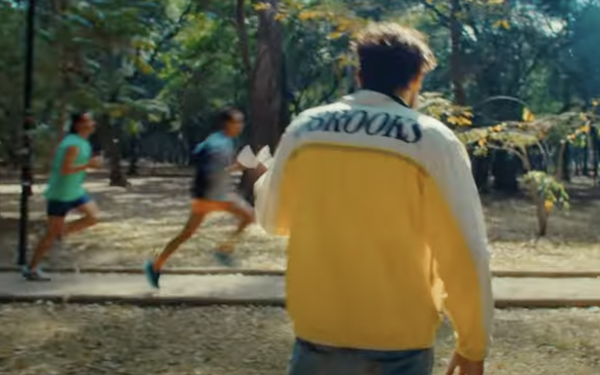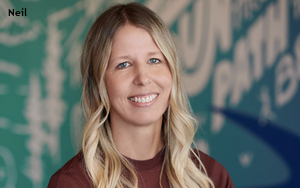
Brooks, long a beloved brand of
serious runners, is introducing “Let’s Run There.” The new global platform is based on the company’s research on
younger consumers -- not just runners but all active people. It also reflects how differently they view the connection between exercise, wellness, socializing, and mental health. Amanda Neil, vice
president of the Seattle-based company's global brand strategy and marketing, tells Marketing Daily what’s behind the launch.
Marketing Daily: Brooks has used the
“Run Happy” mantra since 1999. How does this new platform build on that?
Amanda Neil: “Run Happy” has been an incredible positioning for us, conveying the
positive effects of the run. But the reality is, joy is a temporary state. It is something you feel in the moment and then move on. And when we dug in, we learned that the run leads to this
higher-order feeling. We use a made-up word and call it aliveness.
advertisement
advertisement
Joy is just a moment on this journey. The goal you're trying to achieve is to unlock something special inside you, this new
energy source that helps you feel alive.
It’sa crazy world out there. And if we can take a step back and feel alive, there's something powerful there.
Marketing Daily: Can
you say more about this evolution in running?
Neil: A lot has changed in the consumer mindset. Wellness isn’t a new concept, but we’ve seen shifts in how consumers
approach it. It’s about balance, not just mental and physical health, but also social health.
That’s a newer dimension that came out of the pandemic. We were all starved for that
powerful human connection. Our research shows people tapping those three [kinds of health] in different ways. Maybe they started running to lose a little weight and found mental clarity. Or they are
new moms, and their weekly run club is their needed social connection.
There's fluidity in the role that the run plays in their life. It looks and feels different at different moments, leading
to this new energy.
Marketing Daily: The new ads are full of people, not the classic “solitary road runner, alone in their dedication” imagery. Is that all about this new
social aspect?
Neil: You can get joy and energy as an individual. But with a run crew, that energy is amplified. When you look at the younger generation of runners, that social element
is important. Go down a running path in any city, and you’ll see that. That’s a big opportunity for us.
Marketing Daily: Has tech and the popularity of running apps played a
role?
Neil: Yes, it’s like that joke, "If it’s not on Strava, it didn’t happen." People can connect through social even if they are running on their own. The root of
this campaign is the idea of a journal, capturing your feelings, emotions, mindsets, goals and memories. If you think about it, Strava and Instagram are modern-day versions of journals.

Marketing Daily: Many
expected the running category to slow down after the pandemic boom, but it hasn’t. Brooks just posted record financial results. Competitors like On Running and Hoka are also doing well. How does
Brooks differentiate itself?
Neil: For decades, we've marched to the beat of our own drum. There's a uniqueness to our energy and our personality. It’s a little quirky, which
people have seen in past guerilla marketing activations. People see us as bold and optimistic. And there’s an element of realness – in our ads, there’s no posing or faking. The
people in this campaign are real runners, real friends and in real run clubs.
Marketing Daily: My perception is that you talk less about shoe technology than other brands. Is that
accurate?
Neil: The heart of our communication strategy is helping the runner understand the experience. We offer the best fit, feel, and ride, as well as the overall experience you get
from the run. It’s more of a higher-order emotional state. And yes, we're going to talk about the product. But we dial it in at the right place in the journey. The consumer who wants that
information is going to find it. We know runners have, on average, no more than three brands in their consideration set. And if you're not one of those three brands, the data shows that if you're
going to get there, it’s via an emotional connection, not a functional one.
Marketing Daily: This is your largest campaign since moving creative in-house a few years
back, up 19% from brand spending last year. What’s the media strategy?
Neil: We're surrounding them on connected TV, OTT, and paid social. We're getting out in the wild more than
we have. There was a time when everyone went digital, and content was king. But people are back out now. They’re running and spending more time outside. We're trying to intersect them where
they're at and get our logo in front of new runners. We’re doing lots of disruptive out-of-home, including takeovers in New York, Tokyo and Seoul. We’re also running in sports, like the
NBA playoffs and Stanley Cup playoffs.
Marketing Daily: Big plans for the Paris Olympics?
Neil: We take a different approach than other brands, with more guerilla,
on-the-ground experiences. We’ll be there with high-profile content creators and doing man-on-the-street local content production. We’ve also got a couple of incredible athletes, and we're
going to tell their stories in a unique way through some content series online. And I’m already looking forward to L.A. in 2028!